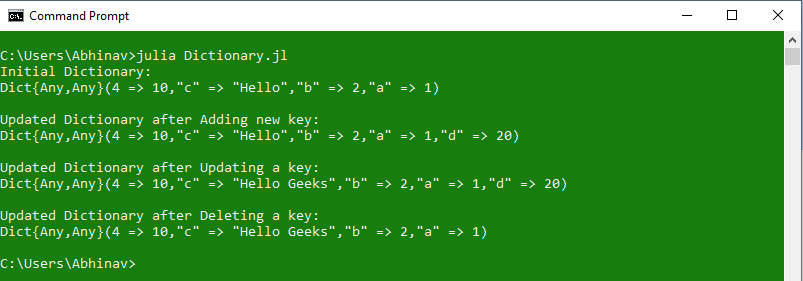Julia 中的字典是键值对的集合,其中字典中的每个值都可以通过其键进行访问。这些键值对不必是相同的数据类型,这意味着字符串类型的键可以保存任何类型的值,如整数、字符串、浮点数等。字典的键永远不会相同,每个键必须是唯一的.这不适用于值,根据需要,值可以相同。默认情况下,字典是一个无序的数据集合,即它不维护插入键的顺序。
字典更像是一个数组,但在字典中,索引可以是任何类型,而在数组中,索引只能是整数。
字典中的每个键都映射到一个值。因为键必须是唯一的,两个键可以映射到两个相同的值,但两个不同的值不能映射到一个键。
句法:
Dictionary_name = Dict(“key1” => value1, “key2” => value2, …)
创建字典
Julia 中的字典可以使用预定义的关键字 Dict() 创建。该关键字接受键值对作为参数,并通过基于键值对的数据类型定义其数据类型来生成字典。如果值的数据类型已知,还可以预先定义字典的数据类型。这可以通过在“ Dict ”关键字之后的大括号内定义数据类型来完成。这个具有预定义数据类型的字典称为Typed Dictionary 。
句法:
Dictionary_name = Dict{Key_datatype, Value_datatype}("Key1" => value1, "Key2" => value2, ...)
例子:
# Julia program to illustrate
# the use of Dictionary
# Creating an Empty dictionary
Dict1 = Dict()
println("Empty Dictionary = ", Dict1)
# Creating an Untyped Dictionary
Dict2 = Dict("a" => 1, "b" => 2, "c" => 3)
println("\nUntyped Dictionary = ", Dict2)
# Creating a Typed Dictionary
Dict3 = Dict{String, Integer}("a" => 10, "c" => 20)
println("\nTyped Dictionary = ", Dict3)
输出: 
从字典访问元素
可以使用字典的键访问字典中的元素。这些键在字典中是唯一的,因此每个键都有一个值。也可以使用 for 循环访问键值对。
句法:
Dictionary_name[key_name]
or
Dictionary_name[:key_name]
例子:
# Julia program to illustrate
# the use of Dictionary
# Creating a Dictionary with String keys
Dict1 = Dict("a" => 1, "b" => 2, "c" => "Hello")
# Accessing dictionary values using keys
println(Dict1["b"])
println(Dict1["c"])
# Creating a Dictionary with Integer keys
Dict2 = Dict(1 => 10, 2 => 20, 3 => "Geeks")
println(Dict2[1])
println(Dict2[3])
# Creating a Dictionary with Symbols
Dict3 = Dict(:a => 1, :b => "one")
println(Dict3[:b])
输出: 
get()函数:
Julia 提供了一个预定义的函数来访问字典的元素,称为get()函数。该函数接受 3 个参数:字典名称、键和一个默认值,如果找不到键则打印。
句法:
get(Dictionary_name, Key_name, Default Value)
例子:
# Julia program to illustrate
# the use of Dictionary
# Creating a Dictionary with mixed-typed keys
Dict1 = Dict("a" => 1, "b" => 2, "c" => "Hello", 4 => 10)
# Accessing using get() function
# Passing '0' as default value
println(get(Dict1, "b", 0))
# Passing String as Default value
println(get(Dict1, "d", "Sorry, no such key"))
输出: 
从字典访问键和值:
Julia 中的字典允许一次访问所有键和所有值。这可以通过使用预定义的关键字keys和values 。
句法:
Keys = keys(Dictionary_name)
Values = values(Dictionary_name)
例子:
# Julia program to illustrate
# the use of Dictionary
# Creating a Dictionary with mixed-typed keys
Dict1 = Dict("a" => 1, "b" => 2, "c" => "Hello", 4 => 10)
# Accessing all the Keys
# using 'keys' keyword
Keys = keys(Dict1)
println("Keys = ", Keys)
# Accessing all the Values
# using 'values' keyword
Values = values(Dict1)
println("Values = ", Values)
输出: 
打印键值对:
使用for循环,可以一次打印字典的所有键值对。这是通过迭代字典的每个键然后访问该键的相应值来完成的。
示例 1:使用 Dictionary 作为可迭代对象
# Julia program to illustrate
# the use of Dictionary
# Creating a Dictionary with mixed-typed keys
Dict1 = Dict("a" => 1, "b" => 2, "c" => "Hello", 4 => 10)
# Printing key-value pair using
# Dictionary as an iterable object
for i in Dict1
println(i)
end
输出: 
示例2:逐个访问每个键
# Julia program to illustrate
# the use of Dictionary
# Creating a Dictionary with mixed-typed keys
Dict1 = Dict("a" => 1, "b" => 2, "c" => "Hello", 4 => 10)
# Printing key-value pair by
# accessing each key one-by-one
for i in keys(Dict1)
println(i, " => ", Dict1[i])
end
输出: 
示例 3:通过使用 (key, value) 元组
# Julia program to illustrate
# the use of Dictionary
# Creating a Dictionary with mixed-typed keys
Dict1 = Dict("a" => 1, "b" => 2, "c" => "Hello", 4 => 10)
# Printing key-value pair by
# using key and value tuples
for (i, j) in Dict1
println(i, " => ", j)
end
输出: 
修改字典的元素
字典元素的修改包括添加新键、修改现有键值和删除键的过程。元素的修改不包括重命名字典的键,但是,可以通过删除现有键并添加另一个具有相同值的键来完成。
# Julia program to illustrate
# the use of Dictionary
# Creating a Dictionary with mixed-typed keys
Dict1 = Dict("a" => 1, "b" => 2, "c" => "Hello", 4 => 10)
println("Initial Dictionary: \n", Dict1)
# Adding a new key
Dict1["d"] = 20
println("\nUpdated Dictionary after Adding new key: \n", Dict1)
# Updating existing key
Dict1["c"] = "Hello Geeks"
println("\nUpdated Dictionary after Updating a key: \n", Dict1)
# Deleting an existing key
Dict1 = delete !(Dict1, "d")
println("\nUpdated Dictionary after Deleting a key: \n", Dict1)
输出: 
字典方法
| Methods | Description |
|---|---|
| get() | Used to return the value stored for the specified key, or the given default value if no mapping for the key is present. |
| get!() | Used to return the value stored for the specified key, or if no mapping for the key is present, store key => default, and return default. |
| getkey() | Used to return the key matching argument key if one exists in collection, otherwise return default. |
| keytype() | Used to return the key type of the specified array. |
| merge() | Used to construct a merged collection from the specified collections |
| merge!() | Used to update collection with pairs from the other collections. |
| pairs() | Returns an iterator over key=>value pairs for the specified collection that maps a set of keys to a set of values. |
| valtype() | Used to return the value type of the specified array. |